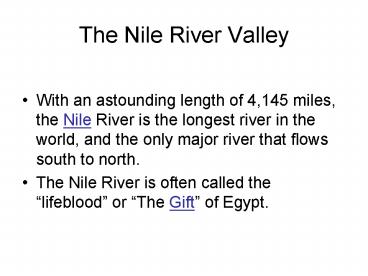The Nile River Valley
1 / 14
Title:
The Nile River Valley
Description:
The Nile River Valley With an astounding length of 4,145 miles, the Nile River is the longest river in the world, and the only major river that flows south to north. –
Number of Views:120
Avg rating:3.0/5.0
Title: The Nile River Valley
1
The Nile River Valley
- With an astounding length of 4,145 miles, the
Nile River is the longest river in the world, and
the only major river that flows south to north. - The Nile River is often called the lifeblood or
The Gift of Egypt.
2
Upper and Lower Egypt
- Ancient Egypt includes two regions, upper
(southern) and lower (Northern) Egypt
3
Blue and White Nile
- At its source, The Nile is 2 separate rivers the
Blue Nile flows out of the mountains and meets
with the White Nile.
4
Cataracts
- Along the Nile there are locations called
cataracts. The cataracts prevented invasions from
the South along the Nile River. The rushing and
swirling water was too difficult to travel along.
5
Geography of Egypt
- Harsh deserts surrounded the Nile river. The
Libyan and Eastern deserts acted as a natural
barrier against invasions. - The Nile River flooded each year to create a long
narrow corridor about 12 miles wide of very
fertile soil. - When the land was covered in silt ,it looked
black. They called this the black land or Kemet. - The dry area looked red so they called it the red
land.
6
Delta
- Before the Nile reaches the Mediterranean Sea, it
splits into many branches. These waterways form a
fan-shaped area of fertile land called a delta.
7
Flood season
- The Inundation was the time from June to
September. This was the time of the flood. During
this time, Egyptians were paid to work for the
Pharaoh on building projects.
8
Flood season
- The Emergence of the land from the water
covering was from October to February. During
this time, Egyptians planted and captured as much
water as possible in irrigation ditches. - The last of the three seasons was the drought
season. During the drought, the harvest took
place.
9
Papyrus
- Papyrus was one of the most versatile plants
growing along the Nile. The plant was used to
make paper, sandals, boats, ropes, and even
paintbrushes.
10
Hieroglyphics
- The Egyptians came up with a writing system
called hieroglyphics. It was a combination of
pictures and sound symbols. - Scribes wrote on papyrus.
11
People of the Nile
- Egyptian people also ate fish from the river, but
the Pharaoh never ate fish because it was
considered unclean from the Nile waters. - Most Egyptians were farmers. They lived in
mud-brick one story houses on small rented plots
of land.
12
Advances in farming
- Canals were dug from the Nile to the farms for
irrigation. Egyptians also used a shadoof (bucket
attached to a long pole) to get water from the
river.
13
Uniting Egypt
- At first Upper and Lower Egypt were not united.
- Upper Egypt was symbolized by a white cone-shaped
crown. - Lower Egypt was symbolized by a red crown.
- Around 3100BC, Narmer (Menes) from Upper Egypt
conquered Lower Egypt and married one of their
princesses, uniting both kingdoms.
14
Dynasties
- Menes is considered Egypts first Pharaoh.
- He also created the first dynasty (line of rulers
from the same family) in Egypt. - He also built a new capital city that was later
called Memphis. - From 3100 BC to 332 BC a series of 32 dynasties
ruled Egypt. These time periods are known as the
Old Kingdom, Middle Kingdom, and New Kingdom.






























![[PDF] The Nile: Travelling Downriver Through Egypt's Past and Present (Vintage PDF](https://s3.amazonaws.com/images.powershow.com/10123499.th0.jpg?_=20240907061)
